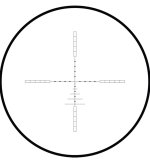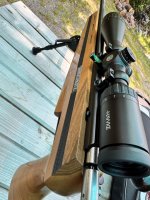Brendon, I think there's already a lot of great suggestions in this topic from the other members. Hopefully I won't overlap too much on what others have already said. It can be complicated, yes! I'll try to keep this concise:
Technical Bits of a Scope:
This is an excellent video explaining the mechanics of a scope by a canadaguns member:
I also wanted to add: I wouldn't worry too much about "rimfire scopes" vs "regular scopes". Often times it's just the difference in reticle. Don't let this limit you. (more info on this below)
Purpose of Scope (or Rifle):
When it comes to precision rifles, there's a big difference between "hitting something" and "chasing groups". If you're shooting a huge steel plate at 100 yards, even very low power scopes will get you there. But if you're looking to "chase groups" (i.e. 5 shots but only 1 hole at 50 yards), then you'll want high power scopes. If this is for hunting, weight is an important factor. Something like 2-7 or 3-9 will get you a pretty close image to "hit something", but not really for precision at longer distances. Whereas a 5-25x56 may not be suitable for hunting - those are more for competition shooting or specialized benchrest shooting. Don't be surprised to see 5-25 or 6-24 scopes on a lot of 22LR rifles. There's nothing that say "regular scopes" can't be used on rimfires, if the scope has a reticle you like (crosshair thing) and it fits the type of shooting you want to do, go for it. I do recommend, before buying, to have a look through the scope at a gun shop so you know what you're getting quality-wise. Because if you're not happy with it (it's too dim, blurry, poor quality, etc.), don't buy it!
Budget:
There are scopes for practically any and every budget out there - from the cheapest to the most expensive. It would be a good idea to set a personal budget and work with that. There's a huge quality difference between a $150 scope and a $700 scope. But the difference is much less when you compare a $700 scope vs a $900 scope.
Bare Minimum I Recommend:
Whichever scope you choose, I HIGHLY recommend you choose one with Parallax Adjustment. In my opinion, this is a 100% must have feature. It should be mandatory on all scopes. I stopped buying scopes that don't have Parallax. Second, I think picatinny rails for the rifle scope base is also 100% mandatory. A pic-rail will give you far more flexibility for mounting than rings-on-receiver. Different scopes have different dimensions and a pic-rail will give you A LOT more positional adjustments for eye relief, comfortable neck and cheek position, and sometimes it will be the difference between being able to mount a scope or not. There are a lot of manufacturers that make pic-rail scope bases for the CZ 457, I highly recommend the one from MDT (made in canada).
Gun Shop Sales People:
As some others have said, some folks that work at shops may point you to a particular product that they want to sell, but may not be in your best favour. Some sales people are fantastic. Most sales people will ask you the same questions I listed above (technical requirements, purpose, budget). It's important to do your homework so you know what they're selling you. Most gun shops (if they have such supplies and inventory available), will be happy to assist with offering recommendations for scope rings and compatibility (and some even help test-fit!). As I mentioned above, sales folks are usually more than happy to let you look through the scopes for you to get an idea of the quality and features before you buy. I almost never buy scopes without first having a try looking through them.
Others:
Some other members also mentioned fine tune adjustments like cheek risers, eye height, LOP, etc. If your CZ 457 is the factory wood or synthetic stock, you won't have any adjustability. Once you get more serious into rifle shooting, you can upgrade the chassis to make the gun fit you perfectly (when you do, the ring height will be less of a concern because of the added adjustments).
Back to Your Question:
2-7 and 3-9x will give you decent zoom for casual plinking. But if you want to get serious, you'll want something that stretches out to 14 or 16, or even more (past 20). Decide on a scope (with parallax), get a scope base (picatinny rail), then get the rings to fit. In short: there's no simple answer to this - it comes down to budget, technical requirements, purpose and type of shooting. Good luck!









































































